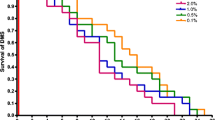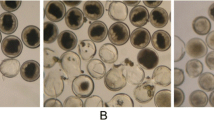Abstract
Recent findings of Alaria alata mesocercariae in wild boars and other animals in Europe reinforced the concern about the public health risk posed by this parasite especially if the game meat is insufficiently heated during preparation. Cooking and freezing are effective methods for the inactivation of parasites in meat whereas refrigeration is considered as an essential part of the Good Hygiene Practice. Additionally, microwave dielectric heating may represent an equally effective tool for parasite inactivation. Therefore, isolated vital mesocercariae were examined with respect to their resilience against heating, refrigeration, freezing, and microwave heating. A. alata mesocercariae stored in Ringer’s solution do not survive heating temperatures that exceed 60.0 °C. Similarly, exposure to microwave heating ensured an inactivation of all parasite developmental stages after 90 s of treatment. In contrast, the parasites’ tolerance towards cold is far higher as the mesocercariae survived refrigeration temperatures (4.0 ± 2 °C) in Ringer’s solution for up to 13 days. An effective inactivation by cold is therefore only guaranteed if the infested game meat is frozen to a core temperature of −13.7 °C for a minimum of 2 h at least. Game meat should be handled with the same or even higher caution than meat of husbandry animals since wild animals may be infected with parasites or other zoonotic agents that are not common in livestock. It is therefore of crucial importance that appropriate temperature time protocols are used for the reliable inactivation of these zoonotic agents.




Similar content being viewed by others
References
Adams AM, Miller KS, Wekell MM, Dong FM (1999) Survival of Anisakis simplex in microwave-processed arrow tooth flounder (Artheresthes stomias). J Food Prot 62:403–409
Archer DL (2004) Freezing: an underutilized food safety technology? Int J Food Microbiol 90:127–138. doi:10.1016/S0168-1605(03)00215-0
BfR, Bundesinstitut für Risikobewertung (2007) Wildschweinfleisch kann den gefährlichen Duncker’schen Muskelegel enthalten (Stellungnahme Nr.027/2007 des BfR vom 1.Juli 2007). http://www.bfr.bund.de/cm/343/wildschweinfleisch_kann_den_gesundheitsgefaehrlichen_dunckerschen_muskelegel_enthalten.pdf. Accessed 08 June 2014
Borch E, Arinder P (2002) Bacteriological safety issues in red meat and ready-to-eat meat products, as well as control measures. Meat Sci 62:381–390. doi:10.1016/S0309-1740(02)00125-0
Bugge G (1942) Das sogenannte Muskeldistomum, Agamodistomum suis, ein Bewohner der Bauchhöhle des Schweines. Tierärztl Rdsch 48:146–151
Capo V, Despommier DD (1996) Clinical aspects of infection with Trichinella spp. Clin Microbiol Rev 9:47–54
Çetünkaya H, Gargili A, Altaş K (2006) Effects of microwave cooking on the infectivity of Toxocara canis (Werner, 1782) larvae in the liver of paratenic host mice. Turk J Vet Anim Sci 30:533–538
Dollfus RP, Chabaud AG (1953) Distomum musculorum suis, mesocercaria of Alaria alata in the wild boar Sus scrofa L. Ann Parasitol Hum Comp 28:354–364
Dorny P, Praet N, Deckers N, Gabriel S (2009) Emerging food-borne parasites. Vet Parasitol 163:196–206. doi:10.1016/j.vetpar.2009.05.026
Duncker HCJ (1896) Die Muskel-Distomeen. Berl Munch Tierarztl Wochenschr 24:279–282
European Commission (2004) Regulation (EC) No. 854/2004 of the European Parliament and of the Council laying down specific rules for the organisation of official controls on products of animal origin intended for human consumption. http://eur-lex.europa.eu/LexUriServ/LexUriServ.do?uri=OJ:L:2004:226:0083:0127:EN:PDF. Accessed 04 Feb 2014
European Commission (2005) Commission Regulation (EC) No. 2075/2005 of 5 December 2005 laying down specific rules on official controls for Trichinella in meat. http://eur-lex.europa.eu/LexUriServ/LexUriServ.do?uri=OJ:L:2005:338:0060:0082:EN:PDF. Accessed 18 Jan 2014
Farouk MM, Wieliczko KJ, Merts I (2003) Ultra-fast freezing and low storage temperatures are not necessary to maintain the functional properties of manufacturing beef. Meat Sci 66:171–179. doi:10.1016/S0309-1740(03)00081-0
FDA, Food and Drug Administration (2011) Fish and fishery products hazards and controls guidance. http://www.fda.gov/Food/GuidanceRegulation/GuidanceDocumentsRegulatoryInformation/Seafood/ucm2018426.htm. Accessed 12 Oct 2014
Fernandes BJ, Cooper JD, Cullen JB, Freeman RS, Ritchie AC, Scott AA, Stuart PF (1976) Systemic infection with Alaria americana (Trematoda). Can Med Assoc J 115:1111–1114
Font W (1991) Life cycle of Amphimerus elongatus (Trematoda: Opisthorchiidae). J Helminthol Soc Wash 58:24–30
Freeman RS, Stuart PF, Cullen SJ, Ritchie AC, Mildon A, Fernandes BJ, Bonin R (1976) Fatal human infection with mesocercariae of the trematode Alaria americana. Am J Trop Med Hyg 25:803–807
Gamble HR, Bessonov AS, Cuperlovic K, Gajadhar AA, van Knapen F, Noeckler K, Schenone H, Zhu X (2000) International Commission on Trichinellosis: recommendations on methods for the control of Trichinella in domestic and wild animals intended for human consumption. Vet Parasitol 93:393–408. doi:10.1016/S0304-4017(00)00354-X
González-Fuentes H, Hamedy A, von Borell E, Luecker E, Riehn K (2014a) Tenacity of Alaria alata mesocercariae in homemade German meat products. Int J Food Microbiol 176:9–14. doi:10.1016/j.ijfoodmicro.2014.01.020
González-Fuentes H, Riehn K, Koethe M, von Borell E, Luecker E, Hamedy A (2014b) Effects of in vitro conditions on the survival of Alaria alata mesocercariae. Parasitol Res 113:2983–2989. doi:10.1007/s00436-014-3960-3
Große K, Wüste T (2006) Der Dunker’sche Muskelegel Funde bei der Trichinenuntersuchung mittels Verdauungsverfahren. Fleischwirtschaft 4:106–108
Hamoud-Agha MM, Curet S, Simonin H, Boillereaux L (2013) Microwave inactivation of Escherichia coli K12 CIP 54.117 in a gel medium: experimental and numerical study. J Food Eng 116:315–323. doi:10.1016/j.jfoodeng.2012.11.030
Hiepe TH (1985) Lehrbuch der Parasitologie Band 3: Veterinärmedizinische Helminthologie. Fischer Verlag, Stuttgart, pp 130–133
Jakšic S, Suncica U, Fanelli MJ, Vucemilo M (2002) Nachweis von Mesozerkarien des Saugwurms Alaria alata im Wildschweinfleisch. Z Jagdwiss 48:203–207
Kapel CMO (2000) Host diversity and biological characteristics of the Trichinella genotypes and their effect on transmission. Vet Parasitol 93:262–278. doi:10.1016/S0304-4017(00)00345-9
Kapel CMO, Webster P, Lind P, Pozio E, Henriksen SA, Murrell KD, Nansen P (1998) Trichinella spiralis, T. britovi, and T. nativa: infectivity, larval distribution in muscle, and antibody response after experimental infection of pigs. Parasitol Res 84:264–271
Knutson KM, Elmer HM, Wagner MK (1987) Microwave heating of food. J Food Sci Technol 20:101–110
Kotula AW, Murrell K, Acosta-Stein L, Lamb L, Douglass L (1983) Destruction of Trichinella spiralis during cooking. J Food Sci 48:765–768
Kumar V, Pozio E, DeBorchgrave J, Mortelmans J, DeMeurichy W (1990) Characterization of a Trichinella isolate from a polar bear. Ann Soc Belg Med Trop 70:131–136
Lacour SA, Heckmann A, Macé P, Grasset-Chevillot A, Zanella G, Vallée I, Kapel CMO, Boireau P (2013) Freeze-tolerance of Trichinella muscle larvae in experimentally infected wild boars. Vet Parasitol 194:175–178. doi:10.1016/j.vetpar.2013.01.049
Lo MC, Morand S, Galzin R (1998) Parasite diversity/host age and size relationship in three coral-reef fishes from French Polynesia. Int J Parasitol 28:1695–1708
Lundén A, Uggla A (1992) Infectivity of Toxoplasma gondii in mutton following curing, smoking, freezing or microwave cooking. Int J Food Microbiol 15:357–363
McDonald HR, Kazacos KR, Schatz H, Johnson RN (1994) Two cases of intraocular infection with Alaria mesocercaria (Trematoda). Am J Ophthalmol 117:447–455
Mileševic M, Ekert M, Mahnik M (2004) Incidence of mesocercaria of Alaria alata in the meat of wild boars killed in the hunting grounds Povavske sume from 4 September to 10 December, 2003. Veterinarska Stanica 35:215–219
Möhl K, Große K, Hamedy A, Wüste T, Kabelitz P, Lücker E (2009) Biology of Alaria spp. and human exposition risk to Alaria mesocercariae—a review. Parasitol Res 105:1–15. doi:10.1007/s00436-009-1444-7
Morlier D, Thiebault S, Dalcher G, Zeyer B, Muller J, Bader R (1989) A rare etiology of acute occlusion of the small intestine: anisakiasis. Review of the literature apropos of a case. Ann Gastroenterol Hepatol 25:99–103
Murphy TM, O’Conell J, Berzano M, Dold C, Keegan JD, McCann A, Murphy D, Holden NM (2012) The prevalence and distribution of Alaria alata, a potential zoonotic parasite, in foxes in Ireland. Parasitol Res 111:283–290. doi:10.1007/s00436-012-2835-8
Paulsen P, Ehebruster J, Irschik I, Lücker E, Riehn K, Winkelmayer R, Smulders FJM (2012) Findings of Alaria alata mesocercariae in wild boars (Sus scrofa) in eastern Austria. Eur J Wildl Res 58:991–995. doi:10.1007/s10344-012-0642-2
Paulsen P, Forejtek P, Hutarova Z, Vodnansky M (2013) Alaria alata mesocercariae in wild boar (Sus scrofa, Linnaeus, 1758) in south regions of the Czech Republic. Vet Parasitol 197:384–387. doi:10.1016/j.vetpar.2013.05.024
Portier J, Jouet D, Ferté H, Gibout O, Heckmann A, Boireau P, Vallée I (2011) New data in France on the trematode Alaria alata (Göeze, 1792) obtained during Trichinella inspections. Parasite 18:271–275. doi:10.1051/parasite/2011183271
Portier J, Jouet D, Vallée I, Ferté H (2012) Detection of Planorbis planorbis and Anisus vortex as first intermediate hosts of Alaria alata (Goeze, 1792) in natural conditions in France: molecular evidence. Vet Parasitol 190:151–158. doi:10.1016/j.vetpar.2012.06.020
Portier J, Vallée I, Lacour SA, Martin-Schaller R, Ferté H, Durand B (2014) Increasing circulation of Alaria alata mesocercaria in wild boar populations of the Rhine valley, France, 2007–2011. Vet Parasitol 199:153–159. doi:10.1016/j.vetpar.2013.09.029
Pozio E, La Rosa G, Rossi P (1989) Trichinella reference centre. Parasitol Today 5:169–170
Prokopowicz D, Wasiluk A, Rogalska M (2005) Oportunistyczne inwazjepasozytnicze zagrazajace czlowiekowi. Kosmos, Problemy Nauk Biol-Ogiznych 54:109–113
Riehn K, Hamedy A, Große K, Zeitler L, Lücker E (2010) A novel detection method for Alaria alata mesocercariae in meat. Parasitol Res 107:213–220. doi:10.1007/s00436-010-1853-7
Riehn K, Hamedy A, Große K, Wüste T, Lücker E (2012) Alaria alata in wild boars (Sus scrofa, Linnaeus, 1758) in the eastern parts of Germany. Parasitol Res 111:1857–1861. doi:10.1007/s00436-012-2936-4
Riehn K, Hamedy A, Saffaf J, Lücker E (2013a) First interlaboratory test for the detection of Alaria spp. mesocercariae in meat samples using the Alaria spp. mesocercariae migration technique (AMT). Parasitol Res 112:2653–2660. doi:10.1007/s00436-013-3432-1
Riehn K, Lalkovski N, Hamedy A, Lücker E (2013b) First detection of Alaria alata mesocercariae in wild boars (Sus scrofa Linnaeus, 1758) from Bulgaria. J Helminthol 4:1–3. doi:10.1017/S0022149X12000909
Ruszkowski J (1921) Die postembryonale Entwicklung von Hemistomum alatum Dies. auf Grund experimenteller Untersuchung. Bull Intern Acad Polo Sci Classe Math Nat Série B: 236–250
Shea M, Maberley AL, Walters J, Freeman RS, Fallis AM (1973) Intraretinal larval trematode. Trans Am Acad Opthalmol Otolaryngol 77:784–791
Skrjabin KI (1965) Trematodes of animals and man. Jerusalem Ketter Press
Széll Z, Tolnai Z, Sréter T (2013) Environmental determinants of the spatial distribution of Alaria alata in Hungary. Vet Parasitol 198:116.121. doi:10.1016/j.vetpar.2013.08.002
Tang ZW, Mikhaylenko G, Liu F, Mah JH, Pandit R, Younce F, Tang JM (2008) Microwave sterilization of sliced beef in gravy in 7-oz trays. J Food Eng 89:375–383. doi:10.1016/j.jfoodeng.2008.04.025
Toledo R, Esteban JG, Fried B (2012) Current status of food-borne trematode infections. Eur J Clin Microbiol Infect Dis 31:1705–1718. doi:10.1007/s10096-011-1515-4
Tornberg E (2005) Effects of heat on meat proteins—implications on structure and quality of meat products. Meat Sci 70:493–508. doi:10.1016/j.meatsci.2004.11.021
Vadivambal R, Jayas DS (2010) Non-uniform temperature distribution during microwave heating of food materials—a review. Food Bioprocess Technol 3:161–171. doi:10.1007/s11947-008-0136-0
Vallée I, Ferté H, Jouet D, Polack B, Laine-Prade V, Mace P, Heckmann A, Boireau, P (2006) Identification of the trematode Alaria alata in wild boar in east of France. European Multicolloquium of Parasitology, Paris. 24.08.2008-28.08.2008
Venkatesh MS, Raghavan GSV (2004) An overview of microwave processing and dielectric properties of agri-food materials. Biosyst Eng 88:1–18. doi:10.1016/j.biosystemseng.2004.01.007
Walters JC, Freeman RS, Shea M, Fallis AM (1975) Penetration and survival of mesocercariae (Alaria spp.) in the mammalian eye. Can J Ophthalmol 10:101–106
Wasiluk A (2013) Alaria alata infection—threatening yet rarely detected trematodiasis. J Lab Diagn 49:33–37
Acknowledgments
The first author wishes to acknowledge the German Academic Exchange Service (DAAD) and the Mexican National Council of Science and Technology (CONACYT) for the doctoral fellowship. For their comprehensive and qualified technical assistance in the present study, we would like to thank Lutz Gumpert, Lia Kieker, Heiko Wellner, and DVM Jasem Saffaf. This work was financially supported by the German Federal Ministry of Food and Agriculture (BMEL) through the Federal Office for Agriculture and Food (BLE), grant number 2810HS017, and the German Federal Institute for Risk Assessment (BfR), grant number 1329-514.
Conflict of interest
None of the authors of this manuscript has declared any conflict of interest within the last 3 years which may arise from being named as an author on the manuscript.
Author information
Authors and Affiliations
Corresponding author
Rights and permissions
About this article
Cite this article
González-Fuentes, H., Hamedy, A., Koethe, M. et al. Effect of temperature on the survival of Alaria alata mesocercariae. Parasitol Res 114, 1179–1187 (2015). https://doi.org/10.1007/s00436-014-4301-2
Received:
Accepted:
Published:
Issue Date:
DOI: https://doi.org/10.1007/s00436-014-4301-2




